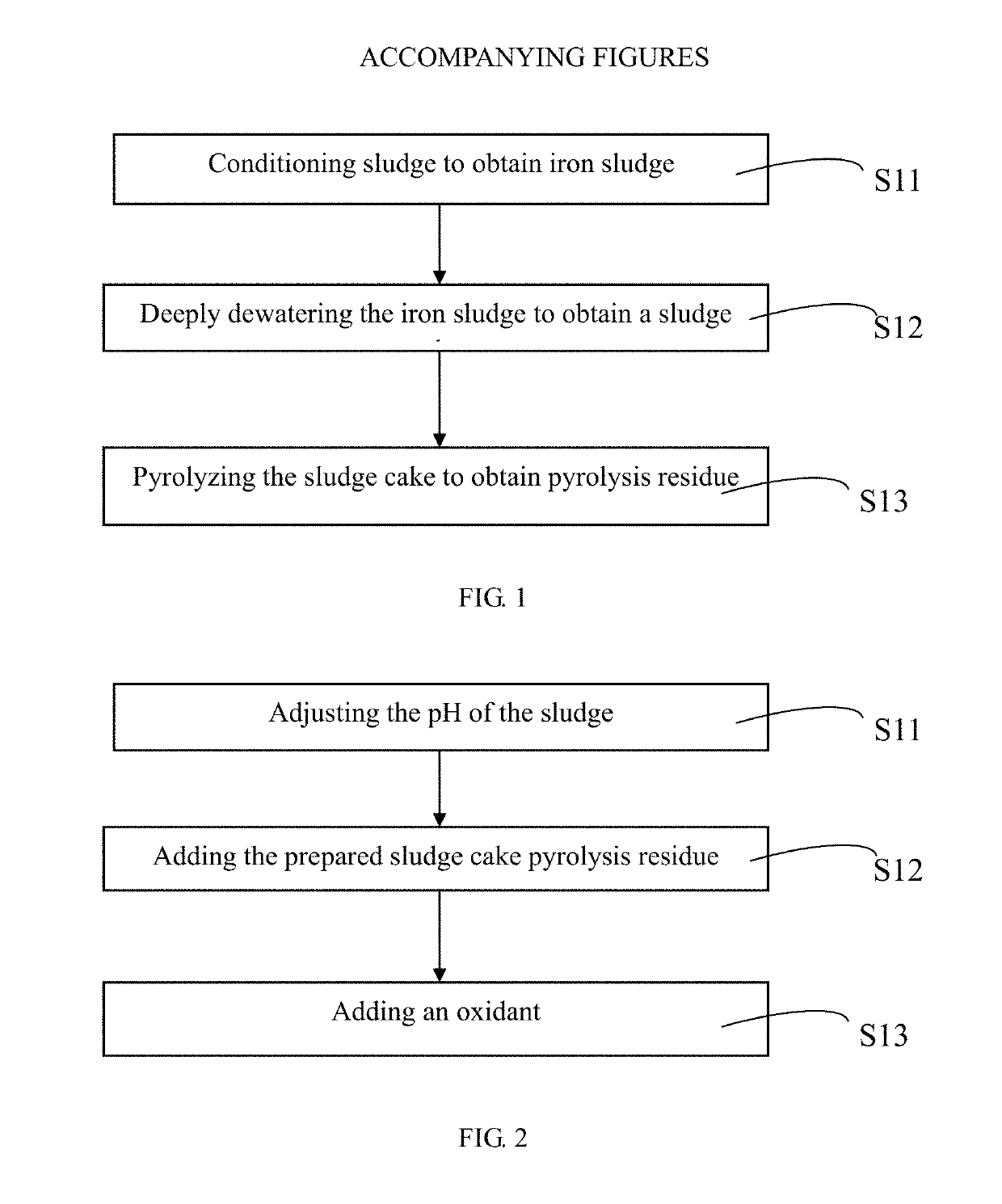Sludge composite conditioner based on iron-containing sludge pyrolysis residue as well as preparation method and use thereof
a technology of sludge pyrolysis and composite conditioner, which is applied in the direction of sludge treatment by oxidation, water treatment compounds, water treatment parameter control, etc., can solve the problems of sludge and water separation difficulties, 83% of sludge in urban sewage treatment plants in china has not been effectively disposed, etc., and achieves better sludge conditioning effect
- Summary
- Abstract
- Description
- Claims
- Application Information
AI Technical Summary
Benefits of technology
Problems solved by technology
Method used
Image
Examples
embodiment 1
[0054]In the present embodiment, preparation and application methods of the iron-containing sludge pyrolysis residue are as follows.
[0055](1) 17 kg of sludge and 128.2 g of FeSO4.7H2O were respectively added to a sludge conditioning tank, and stirring was performed at a stirring rate of 150 rpm and a stirring time of 5 min; then, 104.9 mL of 30% hydrogen peroxide was added, and stirring was performed at a stirring rate of 100 rpm and a stirring time of 30 min to allow the oxidant to fully react with the sludge; finally, 166 g of red mud was added, and rapid stirring was performed for conditioning at a stirring rate of 150 rpm and a stirring time of 5 min. In the above red mud, the percentage of iron is 26%, the mass percentage of aluminum oxide is 18%, the mass percentage of titanium oxide is 6%, and the mass percentage of silica and other minerals is 50%. Finally, 17.4 kg of conditioning sludge was obtained.
[0056](2) The conditioning sludge was dewatered with a plate and frame filt...
embodiment 2
[0061]In the present embodiment, preparation and application methods of the iron-containing sludge pyrolysis residue are as follows.
[0062](1) 17 kg of sludge and 58.57 g of FeCl2 were respectively added to a sludge conditioning tank, and stirring was performed at a stirring rate of 150 rpm and a stirring time of 5 min; then, 104.9 mL of 30% hydrogen peroxide was added, and stirring was performed at a stirring rate of 100 rpm and a stirring time of 30 min to allow the oxidant to fully react with the sludge; finally, 15 g of quick lime was added, and rapid stirring was performed for conditioning at a stirring rate of 150 rpm and a stirring time of 5 min. Finally, 17.3 kg of conditioning sludge was obtained.
[0063](2) The conditioning sludge was dewatered with a plate and frame filter press. 17.3 kg of conditioning sludge was firstly pumped into a 50 L sludge feed tank by a pump, and then the conditioning sludge in the sludge feed tank was pressed into a diaphragm plate frame by a pneum...
embodiment 3
[0067]In the present embodiment, preparation and application methods of the iron-containing sludge pyrolysis residue are as follows.
[0068](1) 15.4 kg of sludge and 73.92 g of FeCl2 were respectively added to a sludge conditioning tank, and stirring was performed at a stirring rate of 150 rpm and a stirring time of 5 min; then, 154.1 mL of 30% hydrogen peroxide was added, and stirring was performed at a stirring rate of 100 rpm and a stirring time of 30 min to allow the oxidant to fully react with the sludge. Finally, 15.4 kg of conditioning sludge was obtained.
[0069](2) The conditioning sludge was dewatered with a plate and frame filter press. 15.4 kg of conditioning sludge was firstly pumped into a 50 L sludge feed tank by a pump, and then the conditioning sludge in the sludge feed tank was pressed into a diaphragm plate frame by a pneumatic press to be dewatered. In order to squeeze the sludge, the pressure of the pneumatic press was increased to 0.8 MPa at a rate of 0.1 MPa / min a...
PUM
| Property | Measurement | Unit |
|---|---|---|
| flow rate | aaaaa | aaaaa |
| mass ratio | aaaaa | aaaaa |
| pH | aaaaa | aaaaa |
Abstract
Description
Claims
Application Information
 Login to View More
Login to View More - R&D
- Intellectual Property
- Life Sciences
- Materials
- Tech Scout
- Unparalleled Data Quality
- Higher Quality Content
- 60% Fewer Hallucinations
Browse by: Latest US Patents, China's latest patents, Technical Efficacy Thesaurus, Application Domain, Technology Topic, Popular Technical Reports.
© 2025 PatSnap. All rights reserved.Legal|Privacy policy|Modern Slavery Act Transparency Statement|Sitemap|About US| Contact US: help@patsnap.com


